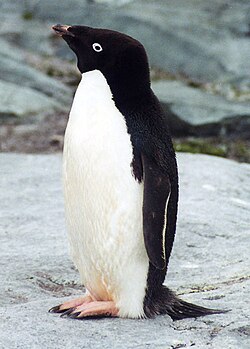Adélie penguin
It has been suggested that this article be merged with The Antarctic Adelie Penguin. (Discuss) Proposed since October 2007. |
| Adélie Penguin | |
|---|---|

| |
| Adélie Penguin on Antarctica's Petermann Island | |
| Scientific classification | |
| Kingdom: | |
| Phylum: | |
| Class: | |
| Order: | |
| Family: | |
| Genus: | |
| Species: | P. adeliae
|
| Binomial name | |
| Pygoscelis adeliae | |

The Adélie Penguin, Pygoscelis adeliae is common along the entire Antarctic coast and nearby islands. Aside from the storm petrel, they are the most southerly distributed of all seabirds. In 1830, French explorer Dumont d'Urville named them for his wife, Adélie. Ross Island supports a colony of approximately half a million Adélie penguins.
Appearance
These penguins are about 30 to 50 cm in length and 4.5 kg (10 lbs) in weight. Distinctive marks are the white ring surrounding the eye and the feathers at the base of the bill. These long feathers hide most of the red bill. The tail is a little bit longer than other penguins' tails.

in Antarctica
Reproduction
Adélie Penguins arrive at their breeding grounds in October. Their nests consist of stones piled together. Sometimes the competition for breeding sites gets so fierce that mothers will steal stones from neighbors' nests. The males summon the females with a low guttural noise followed by a loud cry. A female typically lays two eggs which are brown or green in color. In December, the warmest month in Antarctica (about -2°C), the parents take turns incubating the egg; one goes to feed and the other stays to warm the egg. The parent who is incubating does not eat. In March, the adults and their young return to the sea.
Diet
Although winter data is lacking, the Adélie penguin is known to feed mainly on Antarctic krill during the chick-rearing season, supplemented by Antarctic silverfish and glacial squid. The stable isotope record of fossil eggshell accumulated in colonies over the last 38,000 years reveals a sudden change from a fish-based diet to krill that started two hundred years ago. This is most likely due to the decline of the Antarctic fur seal since the late 1700's and baleen whales in the twentieth century. The reduction of competition from these predators has resulted in a surplus of krill, which the penguins now exploit as an easier source of food.[1]
In popular culture
- Though the mascot of the Linux kernel Tux does not represent a single species of penguin, some believe that he resembles the likings of an Adelie Penguin.
- The 1938 children's book Mr. Popper's Penguins revolves around the story of twelve Adélie penguins.
- The 1971 film Mr Forbush and The Penguins (Mr Forbush and The Penguins at IMDb) follows John Hurt's character as he spends 6 months observing (and becoming attached to) a colony of Adelie penguins.
- The 1988 children's film The Adventures of Scamper the Penguin featured Adélie Penguins.
- The 1995 film The Pebble and the Penguin was based on Adélie courtship behavior wherein the birds build nests of pebbles to attract mates.
- The 1999 film Never Been Kissed the main character, Josie, makes a reference to the penguin's lifestyle.
- The 2005 film Madagascar the Madagascar Penguins featured are presumed to be Adelie Penguins.
- The 2006 Film Happy Feet the main character Mumble, an Emperor Penguin, befriends a group of Cuban-accented Adélie penguins.
- In the webcomic Wally & Osborne, Osborne is an Adelie penguin.
Photo Gallery
References
- ^
S.D. Emslie & W.P. Patterson (2007). "Abrupt recent shift in δ13C and δ15N values in Adélie penguin eggshell in Antarctica". Proc. Natl Acad. Sci. USA. 104 (28): 11666–11669. doi:10.1073/pnas.0608477104.
{{cite journal}}: Unknown parameter|month=ignored (help)








